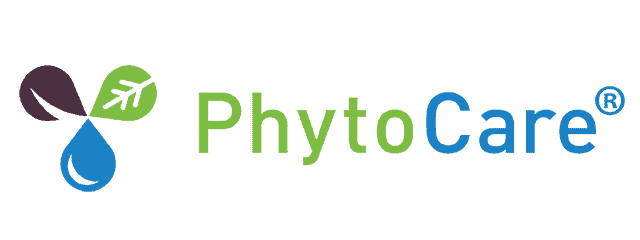C. B. Schmidt, DVM; Robert Tims; Andrew Bents, DVM; Ryan Cain, General Manager; Deb Murray, DVM
Precision Health Technologies, LLC. Technical Team; Hubbard Feeds; Old Fashion Pork, LLC; Veterinary Services Manager, New Fashion Pork
Introduction
Precision Health Technologies LLC (PHT) is North America’s leading supplier of activated natural plant phenolic solutions for animal health and wellness. PHT phenolic products include four Grazix products, as well as several advanced phenolic formulations that are currently in development and field testing. PHT has effectively used its patented manufacturing process to produce safe and effective formulations that prevent as well as improve an animal’s ability to fight off unwanted cellular and immune challenges to the intestinal tract as well as stimulating rapid healing of skin bruising, contusions, and open wounds. One of these new products, PHT Skin Recovery, is an advanced medicinal formulation being specifically developed to accelerate the healing of damaged skin. PHT Skin Recovery formulations capture the properties of Reactive Plant Immunity (RPI) using activated polyphenols to accelerate the healing of damaged skin – just as plants use the same process to rapidly heal and replace damaged cells. All PHT formulations are all-natural helping to reduce our reliance on chemicals and antibiotics in our livestock production facilities. By extending the rapid healing properties of plants, PHT is helping the industry to find effective therapies for those pursuing “antibiotic free” (ABF) or “no antibiotic ever” (NAE) production strategies.
Plant Phenolic Skin Solutions
Why do plants heal so quickly? It’s all about the healing properties of activated polyphenols – the plants natural response to cellular damage and injury. It is common knowledge that plants heal quickly after severe damage from hail, wind, and other traumatic events during their growth cycle. The building blocks of this rapid healing, plant polyphenols, are found in many plants at varying levels. PHT has studied a wide variety of plants and the phenolic response to identify those best able to support healing in animals. Specifically, PHT has discovered that animals with damaged skin as well as active skin lesions will respond quickly to activated epidermal cellular cytoplasm which in turn boosts and activates the peroxidase cellular enzyme pathway to reduce, modify and stimulate faster healing and cellular recovery. In other words, we’ve found the activated polyphenols that are best suited to accelerating skin healing and repair.
Dr. Deb Murray, DVM is the Managing Veterinarian for New Fashion Pork, based in Jackson, MN. She has been a leader in evaluating our newest products and I’m grateful that she is able to present some encouraging findings.
Protocol
The studies presented today are from two of five field evaluations that were conducted to test the new skin care and recovery formulation developed by PHT. Selected veterinarians as well as production managers assisted PHT in its evaluation of PHT Skin Recovery for use as a topical application to treat skin lesions. Our objective was to promote granulation and size reduction in the lesion.
Evaluation Protocol
Our directions for application for the product were simple and straightforward:
- Spray a light coating of PHT Skin Recovery on identified skin abrasions.
Label Directions
- On day one and day two, apply a light coat of PHT Skin Recovery twice a day to clean the wound and stimulate lesion healing.
- On day three plus, reduce application to once a day until the lesion is healed.
A 1 mL dose was delivered with each spray. The trial used 450 mL bottles of PHT Skin Recovery.
Each study location was supplied with the PHT Skin Recovery product. Study participants were trained to use the product as outlined above. Each participant was directed to use the solution on damaged areas such as/resulting from:
- GDU and sow skin lesions
- Castration
- Tail docking
- Other applications of skin lesions
Each participant was directed to conduct the trial with controls in place, e.g., a clear “no treatment” and/or a “production SOP” group for comparison purposes. Participants were further directed to take pictures of the control or non-treated lesions vs the treated lesions. All observations and pictures were to be provided to PHT.
Results
PHT Skin Recovery was observed to have very positive effects in the production units where it was tested. Observable lesions were treated with a light spray of 1 mL of skin recovery directly to the affected area twice daily. The spray applications worked rapidly to promote healing and reduce irritation in the GDU and with sow lesions. As shown in photos in Figure 1 and Figure 2, notable positive effects are observable after only 24 hours. It should be noted that shoulder lesions may require additional daily application to stimulate the healing response.
Castration and Tail Dock Lesion Response
Evaluation One
PHT Skin Recovery was observed to have a positive effect on post castration and tail docking wounds – reducing irritation, swelling, and accelerating healing. Castration and tail docking were performed on litters between 4 and 6 days of age. A single dose of PHT Skin Recovery was applied to the affected area post-procedure and was compared to a control litter that received the unit’s Standard Operating Procedure (SOP) for pre- and post-procedure wound care. The SOP included the spraying of iodine and lidocaine prior to castration and an injection of iron and penicillin following castration. The photos in Figure 3 show post-procedure healing with PHT Skin Recovery, and the photos in Figure 4 show post-procedure healing using the unit’s SOP. The litters treated with PHT Skin Recovery showed significantly better healing, including granular sealing, reduced irritation, less swelling, and improved pig comfort overall.
Evaluation Two
Evaluation two was designed to compare three castration procedures as described below in Figure 5, Figure 6, and Figure 7.
Additional Applications
Application to a torn and irritated vaginal canal after farrowing: (24 hr. response)
The subject sow was given a 1 mL spray application of PHT Skin Recovery when the torn vaginal canal was observed by staff (Figure 8). After 24 hours the treated area showed marked healing, reduced swelling, and less inflammation and irritation (Figure 9).
Overview and Discussion
It is well established that natural based plant extracts have been successfully applied to human as well as animal health applications. PHT developmental work with a variety of plant extracts has shown significant positive effects in healing skin abrasions and lesions in livestock. While products based on plant extracts can make no specific therapeutic claims, various plant extracts and activated plant phenols selected by PHT have exhibited observable medicinal healing to damaged tissues. This early clinical research shows the positive effects of PHT patented processes to advance skin health and wellness applications. Field evaluations consistently showed accelerated healing as applied. The actual results shown above demonstrate the cellular benefits of PHT Skin Recovery on the farm and in live production units.
PHT R&D will be working to identify additional applications for PHT Skin Recovery. As part of that effort, we are seeking additional collaborators to help us study the effects of Reactive Plant Immunity on the following skin disorders and conditions:
- Ear necrosis
- Tail biting
- Mammary lesions
- “Greasy pig”
- Shoulder wounds/abrasions
- Facial abrasions in piglets
- Fly and insect irritation
- Sow prolapse (prevention)
Reported Benefits
Through field and barn trials, Skin Recovery clearly accelerates healing of skin wounds in livestock. This new product is:
- Safe, effective, and field verified
- All natural
- Easy to use and apply
- Accelerates healthy skin recovery
- Reduces skin inflammation
- No chemicals or dyes
Figures
Figure 1A-B: Lesion Healing Over 24 Hours
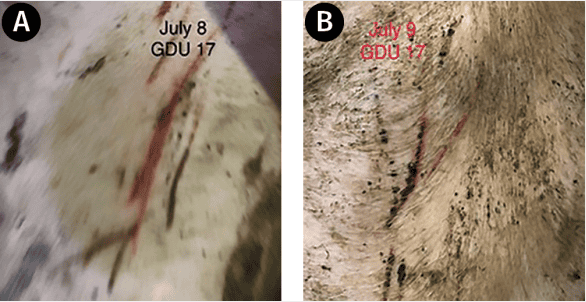
Gilt Development Unit (GDU) Lesions
1 mL of spray applied twice in 24 hours
Observed results in 24 hours:
The wounds treated with PHT Skin Recovery showed significant and rapid improvement over 24 hours. There was significant granulation and wound closure. There was also a clear reduction in lesion size and irritated tissue.
Figure 2A-B: Lesion Healing Over 24 Hours
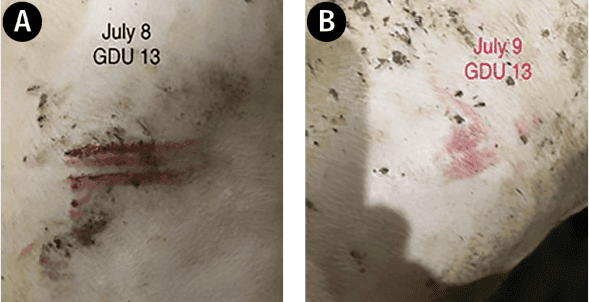
Gilt Development Unit (GDU) Lesions
1 mL of spray applied twice in 24 hours
Observed results in 24 hours:
The wounds treated with PHT Skin Recovery showed significant and rapid improvement over 24 hours. There was significant granulation and wound closure. There was also a clear reduction in lesion size and irritated tissue.
Figure 3A-B: Post-Procedure Healing Over 24 Hours Using PHT Skin Recovery
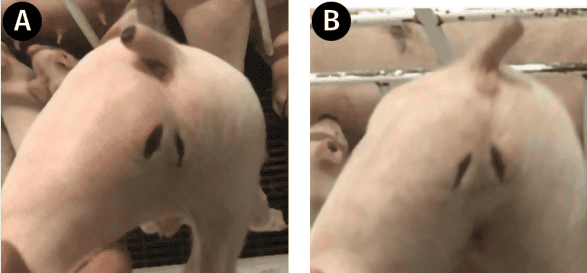
24h post-castration and tail dock results are recorded with the photos below.
1 mL of PHT Skin Recovery applied after castration and skin docking.
Observed results in 24 hours:
Piglets treated with PHT Skin Recovery showed significant granulation and wound closure. Their tails showed rapid healing and granular sealing. The wound areas showed reduced swelling and irritation leading to improved animal comfort.
Figure 4A-B: Post-Procedure Healing Over 24 Hours Using Production Unit SOP
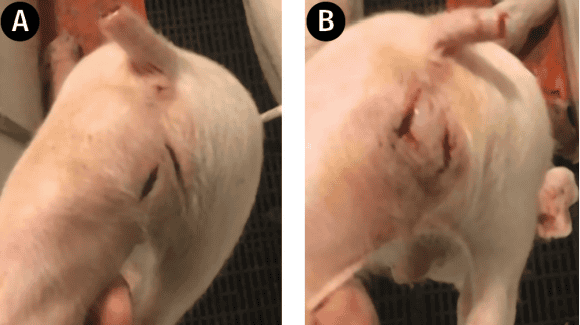
Iodine and lidocaine applied (spray) prior to procedure
Iron and antibiotic injected post-procedure
Observed results in 24 hours:
Piglets treated with the unit’s SOP, there was increased swelling and observable irritation. Piglets show that tails remain redder and swollen post-docking. There was more topical discomfort in the pigs when compared to the pigs who received PHT Skin Recovery.
Figure 5: Post-Procedure Healing Over 48 Hours Using Lidocaine Applied Pre-Castration

Observed results over 48 hours:
The active lesions treated with lidocaine only were still slightly swollen and were healing slower than the PHT Skin Recovery piglets.
Figure 6: Post-Procedure Healing Over 48 Hours Using PHT Skin Recovery Pre-Castration
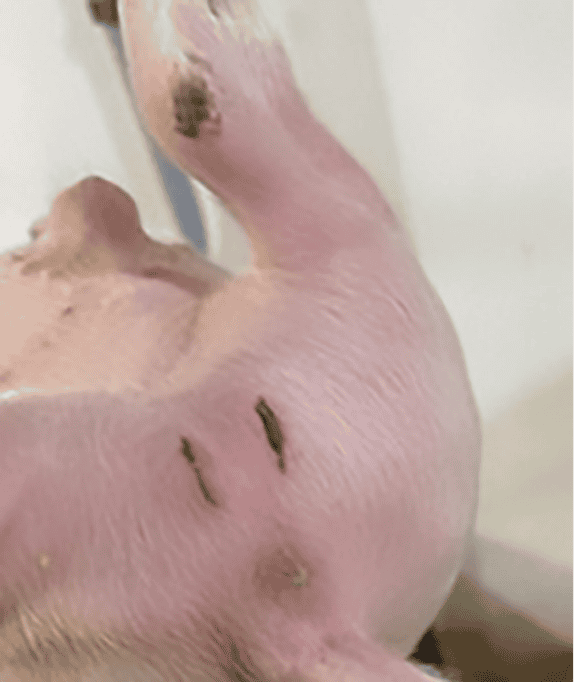
Observed results over 48 hours:
The lesions treated with PHT Skin Recovery prior to procedure showed granulation, wound closure, and improved healing with less swelling.
Figure 7: Post-Procedure Healing Over 48 Hours Using PHT Skin Recovery Pre & Post-Castration
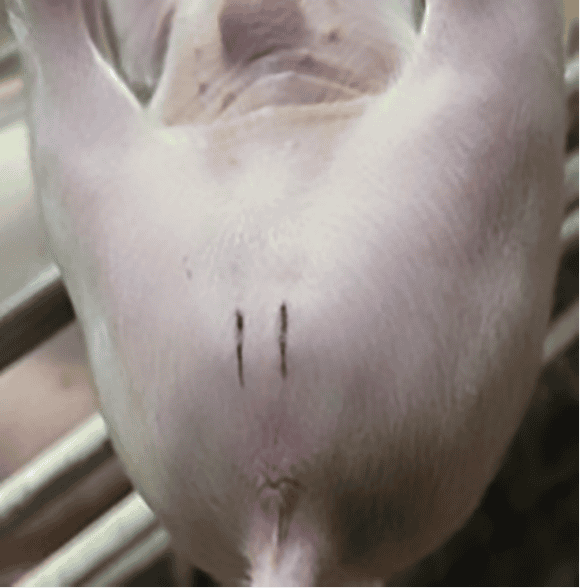
Observed results over 48 hours:
The lesions treated with PHT Skin Recovery prior to and post-procedure showed significantly improved granulation, wound closure, and improved healing with less swelling.
Figure 8: Torn Vaginal Canal Pre-Treatment with PHT Skin Recovery
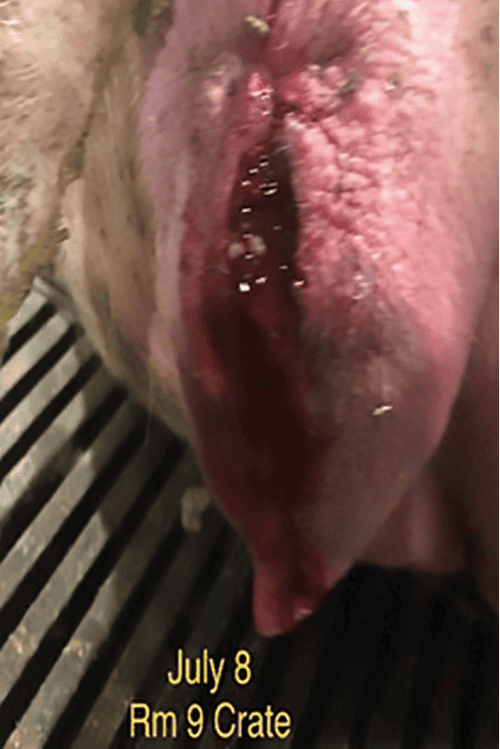
The 24-hour picture shows the response with Skin care.
Figure 9: Torn Vaginal Canal 24 Hours Post-Treatment with PHT Skin Recovery
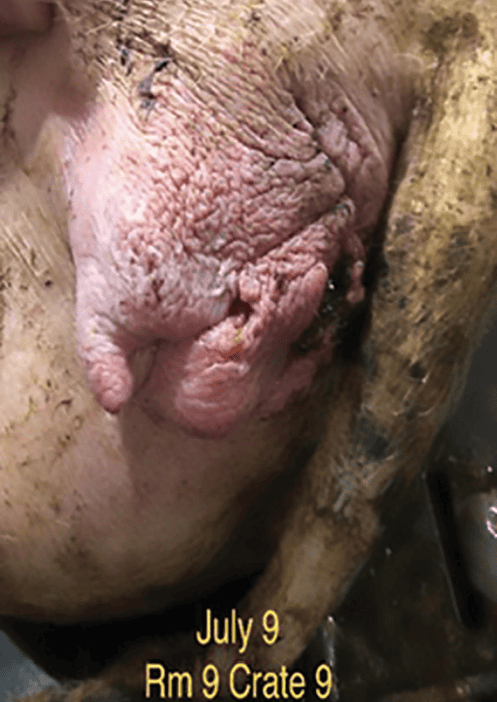
53rd Annual Meeting of the American Association of Swine Veterinarians (February 26 – March 1, 2022)
